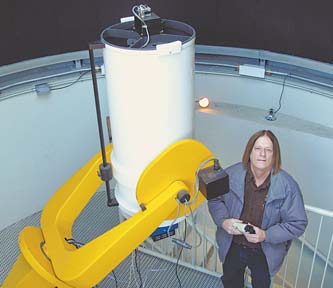Odd orbs continue to baffle NC area

Astronomy professor Daniel Caton stands by a low-light video camera at the campus observatory at Appalachian State University in Boone, N.C. He is hoping to use the cameras to capture a phenomenon known as the Brown Mountain lights.
Associated Press
RALEIGH, N.C.
Two orange orbs, just about 10 feet off the ground, floated past Steve Woody and his father as they hunted deer more than 50 years ago.
The mysterious lights passed them, then dropped down the side of a gorge in the Blue Ridge foothills.
“I didn’t feel anything spooky or look around for Martians or anything like that,” Woody said. “It’s just as vivid now as when I was 12 years old.”
For at least a century, the Brown Mountain Lights have confounded residents and tourists in a rugged patch of Burke County, bobbing and weaving near a modest peak.
Are they reflections from automobile headlights? Brush fires? A paranormal phenomenon, or something natural not yet explained by science?
Whatever the explanation, tourism officials are hoping all those decades of unanswered questions add up to a boost in visitors making their way to scenic outlooks around Linville Gorge with the goal of spotting something mysterious.
Interest in the lights has waxed and waned since the first known printed reference to the phenomenon appeared in the Charlotte Observer in 1913.
The Brown Mountain Lights have drawn serious scientific interest since the 1920s, when the U.S. Geological Survey issued a report concluding the lights were reflections from automobiles, trains and brush fires.
Daniel Caton, a professor in the physics and astronomy department at Appalachian State University, thinks that’s part of the explanation for what people have reported seeing over the years.
But Caton thinks there’s more to the lights, at least in some cases.
Caton said that about seven years ago, he was ready to give up studying the lights when he began hearing from people who said they saw them from mere feet away, not miles across the Linville Gorge.
Those accounts sounded to Caton a lot like firsthand reports of ball lightning, a little-understood but naturally occurring phenomenon involving luminous spheres often said to move or bounce about in the air.
 43
43
